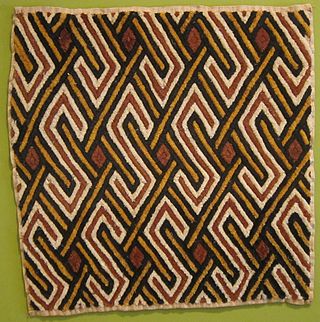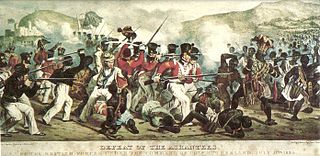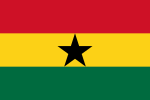
Ghana, officially the Republic of Ghana, is a country in West Africa. It abuts the Gulf of Guinea and the Atlantic Ocean to the south, sharing a border with Ivory Coast in the west, Burkina Faso in the north, and Togo in the east. Ghana covers an area of 239,567 km2 (92,497 sq mi), spanning diverse biomes that range from coastal savannas to tropical rainforests. With nearly 35 million inhabitants, Ghana is the second-most populous country in West Africa. The capital and largest city is Accra; other significant cities include Kumasi, Tamale, and Sekondi-Takoradi.

Demographic features of the population of Ghana include population density, ethnicity, education level, health of the populace, religious affiliations, and other aspects.

Kente refers to a Ghanaian textile made of hand-woven strips of silk and cotton. Historically the fabric was worn in a toga-like fashion by royalty among the Ewe and Akan. According to Ashanti oral tradition, it originated from Bonwire in the Ashanti region of Ghana. In modern day Ghana, the wearing of kente cloth has become widespread to commemorate special occasions, and kente brands led by master weavers are in high demand. Kente is also worn in parts of Togo and Ivory Coast by the Ewe and Akan people there.

The Dagbamba or Dagomba are an ethnic group of Ghana, and Togo. They number more than 3.1 million people. The term Dagbamba is originally extended to refer to other related peoples who were unified by Naa Gbewaa including the Mamprusi and Nanumba. The Dagomba country is called Dagbon and they speak Dagbanli language. Dagbanli is the most spoken language of northern Ghana and second most widely spoken local language of Ghana. Dagbanli belongs to the Mabia (Mole-Dagbani) subgroup of the Gur languages, a large group of related languages in West Africa. The Dagomba practises both patrilineal and matrilineal systems of inheritance.

The Mfantsefo or Fante are an Akan people. The Fante people are mainly located in the Central and Western regions of Ghana, occupying the forest and coastal areas. Their land stretches from the Pra estuary in the west to the Accra borders in the east. The Fante can be broadly categorized into two groups - the Borbor Fante and the non-Borbor Fante. Over the last half century, due to fishing expeditions, Fante communities have been established as far as Gambia, Liberia and even Angola. Major Fante cities in modern Ghana include Agona Swedru, Oguaa, Edina (Elmina), Mankessim.They can also however be found in Sekondi, and Takoradi though those lands belong to another tribe called Ahanta.

The Greater Accra Region has the smallest area of Ghana's 16 administrative regions, occupying a total land surface of 3,245 square kilometres. This is 1.4 per cent of the total land area of Ghana. It is the most populated region, with a population of 5,455,692 in 2021, accounting for 17.7 per cent of Ghana's total population.

Ghanaian cuisine refers to the meals of the Ghanaian people. The main dishes of Ghana are centered around starchy staple foods, accompanied by either sauce or soup as well as a source of protein. The primary ingredients for the vast majority of soups and stews are tomatoes, hot peppers, and onions. As a result of these main ingredients, most Ghanaian soups and stews appear red or orange.

Ghana is a multilingual country in which about eighty languages are spoken. Of these, English, which was inherited from the colonial era, is the official language and lingua franca. Of the languages indigenous to Ghana, Akan is the most widely spoken in the south. Dagbani is most widely spoken in the north.
Articles related to Ghana include:

The Akyem are an Akan people. The term Akyem is used to describe a group of four states: Asante Akyem, Akyem Abuakwa, Akyem Kotoku and Akyem Bosome. These nations are located primarily in the eastern region in south Ghana. The term is also used to describe the general area where the Akyem ethnic group clusters. The Akyem ethnic group make up between 3-4 percent of Ghana's population depending on how one defines the group and are very prominent in all aspects of Ghanaian life. The Akyem are a matrilineal people. The history of this ethnic group is that of brave warriors who managed to create a thriving often influential and relatively independent state within modern-day Ghana. When one talks of Ghanaian history, there is often mention of The Big Six. These were six individuals who played a big role in the independence of Ghana. Of the big six, people of Akyem descent made up the majority.

African textiles are textiles from various locations across the African continent. Across Africa, there are many distinctive styles, techniques, dyeing methods, and decorative and functional purposes. These textiles hold cultural significance and also have significance as historical documents of African design.
Ghanaian names consist of several given names and surnames based on the language of ethnic groups in Ghana: including Akan, Mole-Dagombas, Ga, Ewe and Nzema. Frequently, children are given a "day name" which corresponds to the day in the week when they were born. These day names have further meanings concerning the soul and character of the person. Middle names have considerably more variety and can refer to their birth order, twin status, or an ancestor's middle name. These names are also used among Ghanaians living abroad and among Africans living in the diaspora who wish to identify with their ancestral homeland. During the 18th and 19th centuries, the enslaved people from modern day Ghana in the Caribbean were referred to as Coromantees. Most day names among the Mole-Dagombas are usually given to girls, and few are given to both sexes.

Traditional religions such as the Akan Traditional Religion and Dagbon Traditional Religion are the indigenous religions of Ghana. Islam was the first Abrahamic religion to be introduced in the country between the tenth and 15th centuries, by Muslim traders. Later, Christianity was introduced via contact with the European missionaries. Today, Christianity is the largest religion in Ghana, with substantial adherents of Islam and traditional faiths. Christianity is mainly in the country's south while Islam is based in the north. Islam gained widespread acceptance in northern Ghana after Yaa Naa Zanjina accepted the faith in the 17th century.

The Ghanaian Smock or Tani is a fabric worn by both women and men in Ghana. It is the most popular traditional attire in the country. The fabric is called Tani in Dagbani, while the male and female wear are respectively called Bin'gmaa and Bin'mangli. The smock is formally worn with a hat (zipligu)/ scarf (bobga), footwear (muɣri), and a trouser (kurugu).

The Ghanaian people are a nation originating in the Ghanaian Gold Coast. Ghanaians predominantly inhabit the Republic of Ghana and are the predominant cultural group and residents of Ghana, numbering 34 million people as of 2024, making up 85 per cent of the population. The word "Ghana" means "warrior king". An estimated diaspora population of 4 million people worldwide are of Ghanaian descent. The term ethnic Ghanaian may also be used in some contexts to refer to a group of related ethnic groups native to the Gold Coast.
Dagbani music and dance is a core tradition of the Dagbamba of West Africa. The Dagbamba speak the Dagbanli language. They are the dominant ethnic group in the kingdom of Dagbon found in the Northern Region of Ghana. Music and dance plays a central role in Dagbon. It is through these arts that the Dagbamba have preserved their history over the centuries. The Dagbamba regard dancing as a form of emotional expression, social interaction, a spiritual performance or even physical exercise that aids them articulate or illustrate ideas or tell a story. In most cases, music in Dagbon is accompanied by dancing in order to form a complete story.

The Kingdom of Dagbon (Dagbaŋ) is the oldest and one of the most organised traditional kingdoms in Ghana founded by the Dagomba people (Dagbamba) in the 15th century. During its rise, it comprised, at various points, the Northern, Upper West, Upper East, Savannah Region and North East regions of present-day Ghana. It also covered portions of Burkina Faso, North East Ivory Coast and North West Togo. Since Ghana's independence in 1957, the Kingdom just like all of Ghana's kingdoms and ethnic states has assumed a traditional, customary role.
Yaa is a feminine given name originating from the Akan day naming system, meaning born on a Thursday. Day names are a cultural practice of the Akan people of Ghana. Although some might believe it is mostly practised by Ashanti people, it is actually practised by all Akan people who follow traditional customs. People born on particular days are supposed to exhibit the characteristics or attributes and philosophy, associated with the days. Yaa has the appellation Busuo or Seandze meaning brave. Thus, females named Yaa are supposed to be brave.

The Katamanso War, also known as the Battle of Dodowa, was a war that several tribes united with the British, fought and prevented Ashantis from dominating the coast in 1826. Numerous tribes in the Gold Coast such as the Fantes, Ga, Akyems, Adas were led by the British army to fight the Ashantis. It is classified as one of the "Anglo-Ashanti Wars" according to historical evidence at the National Archives.

















